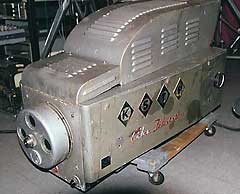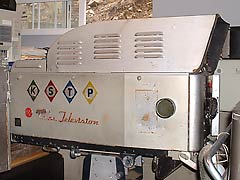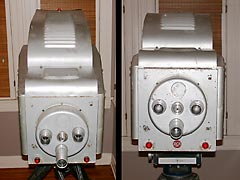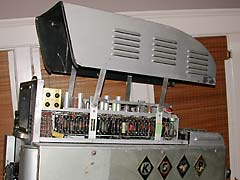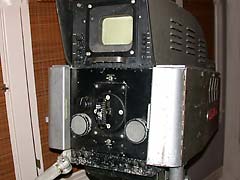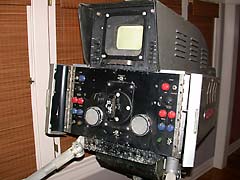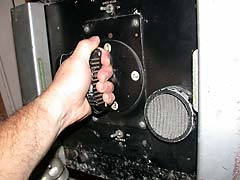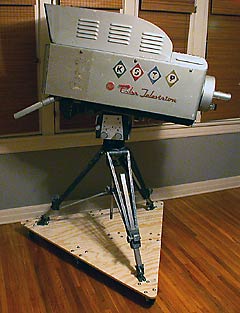 |
|||||||||||
| My dream of owning an antique RCA TK-41 color television camera came true in July 2002. After years of searching to no avail, as a last resort I contacted Chuck Pharis, a prominent Los Angeles-area collector of antique TV broadcast equipment. After considerable thought, Chuck agreed to part with one of the three TK-41 cameras in his collection. Most TK-41's had been scrapped by broadcast facilities long ago because the huge heavy beasts with their power-hungry racks of vacuum tubes and hand-wired circuitry were difficult and expensive to maintain. So finding one, working or not, had been a difficult quest. I had given up numerous times, but my persistence finally paid off and an eye-popping TK-41 color television camera is now proudly displayed in my home.
RCA's TK-40 and 41 series color television cameras had been the exclusive workhorses of the early days of color TV starting in 1953, and were still in limited use as late as the early 1970's in some facilities including the NBC network studios in Burbank, California. But newer more compact cameras requiring much less light and more reliable solid state circuitry had virtually obsoleted the historic giants by the mid 1970's. |
|||||||||||
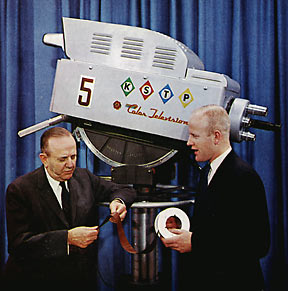 |
|||||||||||
|
My camera when it was new in 1962
|
|||||||||||
| Many TK-41's and their associated rack-mounted power supplies, amplifiers, and control consoles were either hauled to scrapyards or put in storage. But many were donated to colleges and broadcast training schools. Such was the case with my TK-41. In 2003, a fellow in Florida named Ed Allen found my website, and contacted me with more information about the camera's history after it was retired from KSTP-TV, Minneapolis-St. Paul in 1968. He graciously sent photos along with the story. Coupled with a 1962 story in the trade magazine "RCA Broadcast News" (see the link below), the history of my camera is fairly complete. The power of the internet continues to amaze me, and I'm lucky that Ed found me with his Google search and shared his story and photos. | |||||||||||
|
|
|||||||||||
| Kris,
Just surfing the net when I came upon your great website with information on your TK-41C. It certainly is a small world. I was the one who traded the TK41 to Chuck Pharis in exchange for a Norelco PC-70. I thought you might like a little history on that camera and how it got from KSTP to Chuck. Back in late 1968, Hubbard Broadcasting, owner of KSTP, built WTOG-TV in St. Petersburg, Florida. They equipped that station with two RCA TK-44 cameras. At some point KSTP sent two TK-41C cameras to WTOG, but they didn't want them. I began work at Manatee Junior College in 1970. The college had no budget for TV equipment, so I started making the rounds of TV broadcasters throughout Florida in an attempt to beg, borrow or steal some TV equipment. I was pretty successful, getting a bunch of old B/W GE gear from WESH-TV in Orlando, a TK-26 Color Film Chain and a Riker Production Switcher and Special Effects unit from WTVT in Tampa, and the two TK-41's from WTOG. We acquired the equipment from WTVT and WTOG in 1973. Here are a couple of the pictures of the TK-41s while in service at MJC. As you can see, the studio was nothing more than a couple of converted classrooms, very low budget. The TK-26 film chain installation was routine and we began to use it to video tape our 16mm movie collection on 3/4" tape or to distribute them live on a new campus-wide CATV system I built. The TK-41's were another story, and took months of hard work to get them working. After the college got into TV production, I tried to get them to purchase new equipment, but the budget wasn't there. In 1976 funds were granted by the state to build a new Library building. A new TV studio was to be part of that building, but again, my request for new cameras was turned down. Finally, I turned in a request for a complete set of new Image Orthicons for the cameras, along with a note that we could buy new cameras for the same or less money. That did it! I finally got new Sony cameras! But we kept the TK-26 film chain as it was still producing great pictures. The college put the TK-41's up for auction. I was the only bid at $50. The college reluctantly sold me the cameras at that low price, but they kept all of the power supplies, processing amps, encoders, monitors, etc., as they could be used for spares on the TK-26. The TK-41's were stored in a friend's garage for years. In 2000 I saw Chuck's web page and saw he was looking for a TK-41. He agreed to swap me a PC-70 for one of my TK-41 camera heads. We loaded the camera head, cable, and cradle head into my Jeep Cherokee and off I drove to California. That's how the KSTP cameras got from St. Paul, Minnesota to Pasadena, California. Ed Allen |
|||||||||||
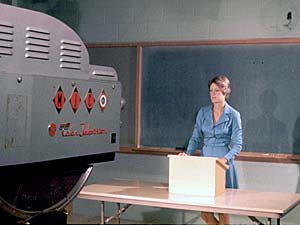 |
|||||||||||
| My TK-41 at Manatee Junior College in Sarasota, Florida - early 1970's after being "retired" from KSTP-TV in Minneapolis-St. Paul. Note the "KST" letters on the camera side panel has been covered with "M J C" and the "P" is covered by a blank dot. | |||||||||||
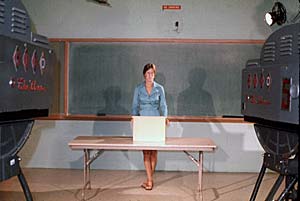 |
|||||||||||
| A 2 camera shoot in a simple classroom. The 3 Image Orthicon pickup tubes in each TK-41 required a tremendous amount of light, so this classroom studio must have had a dedicated air conditioning system to teacher from roasting. | |||||||||||
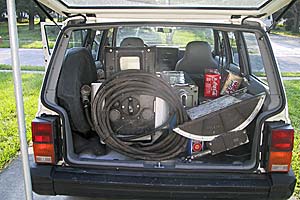 |
|||||||||||
| Ed's jeep with the TK-41 camera head and cradle on it's way from Florida to California. Unfortunately the Houston-Fearless cradle head was not included when I purchased the camera from the previous owner, so I'm looking for one to complete my display. Similar cradle heads were used on other cameras, but the TK-41 is extra-large and unique. | |||||||||||
|
|
|||||||||||
